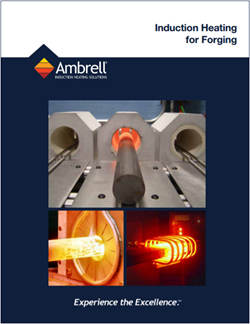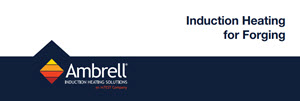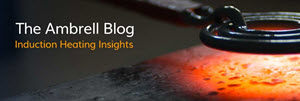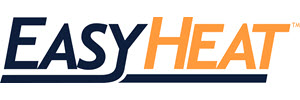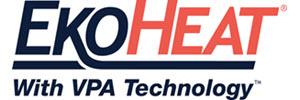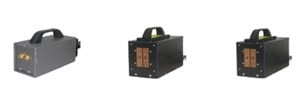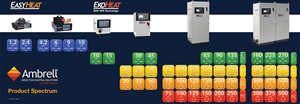Induction Forging
- Home
- Process Applications
- Forging
What is induction forging?
Induction forging is a process where a precisely controlled magnetic field is used to heat metal to be formed into shape using pressure applied by an impact hammer or press.
Induction generates an electromagnetic field in a work coil that induces currents in the conductive material of a workpiece placed within or near the coil. Friction from these currents elevates the temperature of the workpiece prior to forging.
Benefits of Forging with Induction
A superior and flame-free alternative to furnace heating, induction heating provides faster, more efficient heat in forging applications. The process relies on electrical currents to produce heat within the part that remains confined to precisely targeted areas.
High power density means extremely rapid heating, with exacting control over the heated area.
forging Application Notes
Select from our collection of forging notes, taken from years supporting our customers. Read how we helped to solve their process heating challenges.
Heating an area around elliptical hole in steel tube prior to forming; the client had been using a torch for this application.
 Hot Heading Steel Wire: Create Screws
Hot Heading Steel Wire: Create Screws
Preheating steel wire before hot heading to create a screw; they wanted to switch from cold heading to extend tool life.
 Heating Cutting Tools for Forging
Heating Cutting Tools for Forging
An infrared pyrometer was used to monitor the temperature of the part during the heating cycle. Two parts were tested.
 Flattening/Bending Steel Tubes
Flattening/Bending Steel Tubes
Induction forging elevates the temperature much more rapidly than an oven, targeting the precise portion of the part that requires heating every time, presenting a significant advantage over an oven
Induction heating drove the part to forming temperature more rapidly than a torch. Induction heating targets the precise portion of the part that requires heating every time
Testing determined that the magnetic steel rod heated to required temperature within 1.5 seconds with an EASYHEAT LI induction heating system.
 Induction forging silver bars to create collectible coins
Induction forging silver bars to create collectible coins
The client had been using an oven, and forging with induction can present some speed advantages. Unlike an oven, induction heating offers instant on/instant off heating
 Preheating steel rods for forging in a fastener manufacturing process
Preheating steel rods for forging in a fastener manufacturing process
The client targeted an aggressive cycle time, achieve thanks to our process design and the efficiency of induction heating; fast heating means greater manufacturing throughput
 Induction forging rods of various materials and dimensions
Induction forging rods of various materials and dimensions
Each of the rods were placed into the induction forging coil and heated. They achieved the targeted temperature in 30-40 seconds. The coil was designed for a 5 (127 mm) heat zone.
 Preheating a brass rod for forging
Preheating a brass rod for forging
The client wanted to cut the cycle time it was getting from a torch in half, and the Ambrell induction process was able to meet that goal.
 Preheating a billet with induction for forging
Preheating a billet with induction for forging
The client needed to improve the cycle time of their gas furnace, and by preheating it prior to insertion into the furnace, time was saved and the client didn't have to invest in doubling the size of their furnace.
 Preheating a brass assembly for forging blanks
Preheating a brass assembly for forging blanks
The client was using a competitor's system, and it was heating the assembly at a slower rate. They needed to increase their production rate, which this solution was able to achieve.
 Preheating steel rods for forging in a fastener manufacturing process
Preheating steel rods for forging in a fastener manufacturing process
The client targeted an aggressive cycle time, which Ambrell was able to achieve thanks to its process design and the efficiency of induction heating
 Preheating for forging of steel pins
Preheating for forging of steel pins
Fast, precise heating of the pin - 2 minutes and 36 seconds were saved on heating all of the rim's pins when compared to using a torch
 Preheating titanium rods for forging turbine blades
Preheating titanium rods for forging turbine blades
Forging with induction provides increased production rates, repeatable, reliable & consistent heat without flame and hands free heating that involves no operator skill for manufacturing
 Pre Heating Mold Release Push Rod For Forging
Pre Heating Mold Release Push Rod For Forging
To heat the ends of steel rods to 1800°F using induction prior to a forging operation. Processing of the rods includes heating, pressing in a two part die to forge the push rod end, and a final induction heating in a channel coil to temper the rods and relieve the forging stresses.
 Heating Inconel Billets for Forging
Heating Inconel Billets for Forging
A four-turn helical coil is used to deliver uniform heat to the inconel billets. Both size billets heat to 2050°F (1121.1ºC) within 12 seconds.
 Pre Heating Steel For Forging Horse Shoes
Pre Heating Steel For Forging Horse Shoes
Induction forging provides for hands-free heating that involves no operator skill for manufacturing, improved production rates with minimal defects, low pressure and minimal residual part stress with even distribution of heating
What is an application where hot forging should be using instead of forging?
Applications where material failure occurs because of cracking would benefit from hot forging. Reduction in press forces are also beneficial using hot forging.
What are the benefits of induction for forging instead of a forging furnace?
Consistent thruput, efficiency of the process and reduced scale formation are a few benefits of induction forging.
Do you have a guide I can follow?
You can read our blog post 'A Complete Guide to Induction Forging'.
What is through-heating?
The induction forging process produces heat within the part, but the heat is generated near the outside surface and will take time to conduct to the center of the part. Typically, bar-ends up to 20 mm in diameter through-heat in less than 10 seconds, whereas a 75 mm diameter bar will take 150 seconds to heat to the center.
What is hot forging?
Hot forging is when a part is heated above the material recrystallization temperature before forging, typically 1100 °C (2012°F). Hot forging allows a part to be formed with less pressure, creating finished parts with reduced residual stress that are easier to machine or heat treat.
More Forging Resources
Our Induction forging Systems and Equipment
AMBRELL CORPORATION
1655 Lyell Avenue
Rochester, NY 14606
United States
F: +1 585 889 4030
AMBRELL B.V.
Holtersweg 1
7556 BS Hengelo
The Netherlands
AMBRELL Ltd.
Unit 6, Space Business Centre
Tewkesbury Road
Cheltenham, GLOS, GL51 9FL
United Kingdom
F: +31 546 788 154
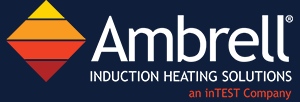

 Forming a Large Steel Tube
Forming a Large Steel Tube Forming a Magnetic Steel Part
Forming a Magnetic Steel Part Forging a magnetic steel rod
Forging a magnetic steel rod